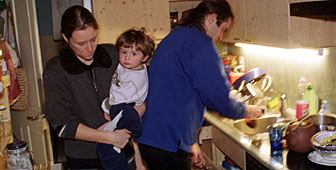Quarter of a million workers live in poverty

The number of “working poor” in Switzerland has risen for the first time in four years, according to a government report.
More than seven per cent of the workforce were unable to get by on their salaries in 2003 – up one per cent on the previous year.
In a statement released on Friday, the Federal Statistics Office said this amounted to at least 231,000 workers aged 20-59.
In all, 137,000 households, comprising 513,000 people and 233,000 children, were living on a financial knife-edge.
Both workers’ and employers’ unions said they were concerned by the findings.
The Federal Statistics Office said single-parent families, foreigners and unskilled workers were most likely to figure among the ranks of the working poor.
The working poor are classed as those who earn less than SFr2,450 ($2,140) a month, or a family with two children earning less than SFr4,450 a month.
Worried
After an explosion in the number of working poor in Switzerland in the early 1990s, the figure had stabilised and had even fallen in recent years, according to the report.
“The percentage of working poor seems to mirror the unemployment rate, but with a delay of two or three years,” said the Federal Statistics Office.
It added that the link could be explained by the fact that increased unemployment brought less job security.
The Swiss Federation of Trade Unions said a weak economy was partly to blame for more and more workers falling into financial hardship.
Union leaders called for the introduction of a minimum wage to provide a safety net for workers.
The Swiss Employers’ Association said it was worrying that salaries were sometimes not enough to live on in a country like Switzerland.
But it said a minimum wage would have to be negotiated between employees and employers rather than with the state.
swissinfo with agencies
231,000 people were classified as “working poor” in Switzerland in 2003.
They represent 7.4% of the working population aged 20-59.
In 2002 this figure stood at 6.4%.
137,000 households, comprising 513,000 people and 233,000 children, were affected.

In compliance with the JTI standards
More: SWI swissinfo.ch certified by the Journalism Trust Initiative



You can find an overview of ongoing debates with our journalists here. Please join us!
If you want to start a conversation about a topic raised in this article or want to report factual errors, email us at english@swissinfo.ch.